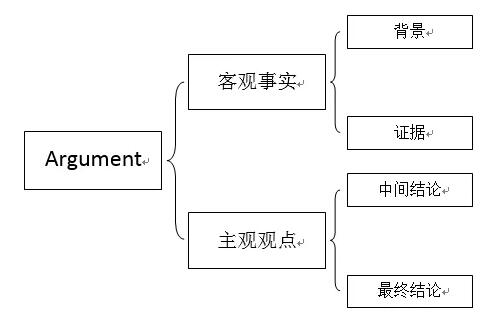
在GRE写作中,对Argument文章结构分析的正确性是Argument成功的基础。如果Argument的文章分析发生错误,将直接影响后续文章中攻击点的正确性,这将导致整篇文章将有颠覆之险。因此,同学们在学习Argument写作这一部分的时候,必须要固定对文章结构的分析方法,来确保自己对文章逻辑结构把控的正确性。
一般而言,一篇Argument文章的逻辑结构可以归纳为下图:

从最笼统的角度来说,任何一个Argument的题目,都是由“客观事实”来推导“主观观点”的过程。其中,由于并非所有客观事实都用于支持结论的产生,因此又需要将“客观事实”分成“背景”和“证据”两个部分;同时,部分题目会出现“主观观点”并非一个的情况,因此就要区分出哪一个主观观点是文章的“最终结论”,而剩下的就是“中间结论”。
整个Argument题库中的每道题,其每一句话基本就是这四个基本元素(背景、证据、中间结论、最终结论)中的一种。而基本的推导方式是,证据推出中间结论,再由中间结论推出最终结论。在题目中可能会出现多个证据,而中间结论则有可能不出现。
一般情况下,对以上四个基本元素的区分,需要划分成以下三个基本步骤来进行:
第一步:区分主观观点与客观事实
区分主观观点和客观事实的目的,就是为了在分析文章的逻辑结构中,先聚焦到全文的结论,这是一篇Argument分析的重中之重。结论没找到,后面所有的事情全都免谈。而一旦找对了全文的结论,那么整篇Argument的逻辑就大体清楚了。在Argument考试中,结论的寻找可以基于以下两个依据:
1) 结论是作者的主观观点,而证据是客观事实信息。
这一定义来自于ETS的官方陈述:“The task consists of a brief passage in which the author makes a case for some course of action or interpretation of events by presenting claims backed by reasons and evidence.”(见3.1)可见,文章的结论必然是作者想要论证的目标,而这个目标必然是作者自己发表的。自然,结论是作者的主观观点。
2) 结论是整篇文章逻辑推导的终点。
同样,这一定义也来自于ETS的官方解释:“conclusion — the end point reached by a line of reasoning, valid if the reasoning is sound; the resulting assertion”。所以,结论一定是文章推导的终点。
在实战中,分析Argument语篇逻辑时,如果先对主观观点和客观事实进行区分,将会对文章的整体推导方向起到有效的指导作用。
例1
The following appeared as part of a letter to the editor of a scientific journal.
"A recent study of eighteen rhesus monkeys provides clues as to the effects of birth order on an individual's levels of stimulation. The study showed that in stimulating situations (such as an encounter with an unfamiliar monkey), firstborn infant monkeys produce up to twice as much of the hormone cortisol, which primes the body for increased activity levels, as do their younger siblings. Firstborn humans also produce relatively high levels of cortisol in stimulating situations (such as the return of a parent after an absence). The study also found that during pregnancy, first-time mother monkeys had higher levels of cortisol than did those who had had several offspring."
Write a response in which you discuss one or more alternative explanations that could rival the proposed explanation and explain how your explanation(s) can plausibly account for the facts presented in the argument.
上题的结论对于不少同学来说有点难找。其实,基于前面所讲的两个原则找结论并不困难:全文中唯一一句主观观点是:“A recent study of eighteen rhesus monkeys provides clues as to the effects of birth order on an individual's levels of stimulation.”。1)由“provides clues”能够看出这就是作者的主观观点;2)整篇文章之后引用的全是实验结果,那么由这些实验结果推导出第一句话,逻辑就很自然。因此第一句话是整篇文章推导的终点。



